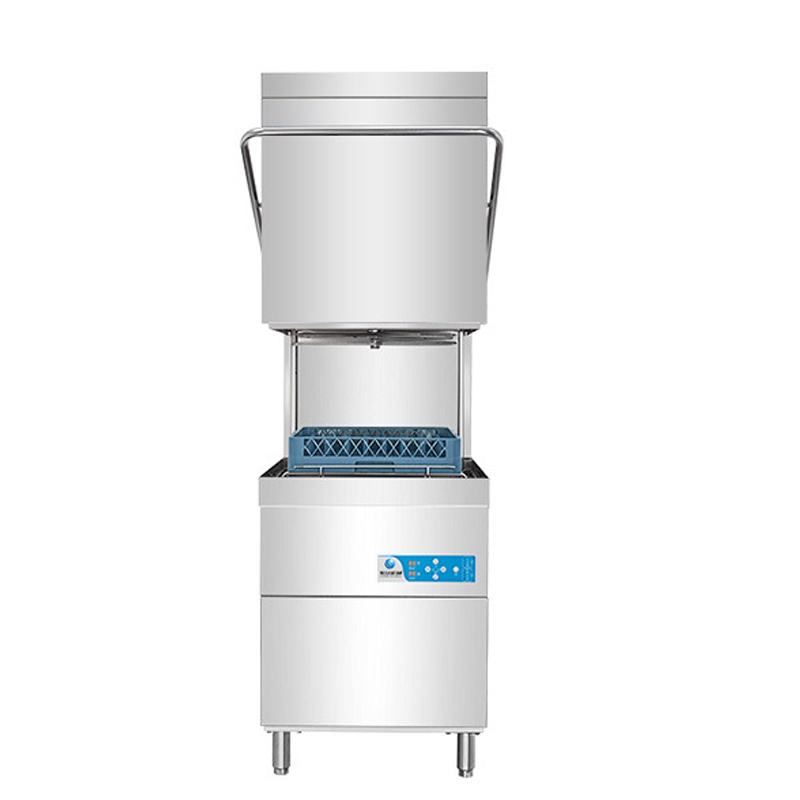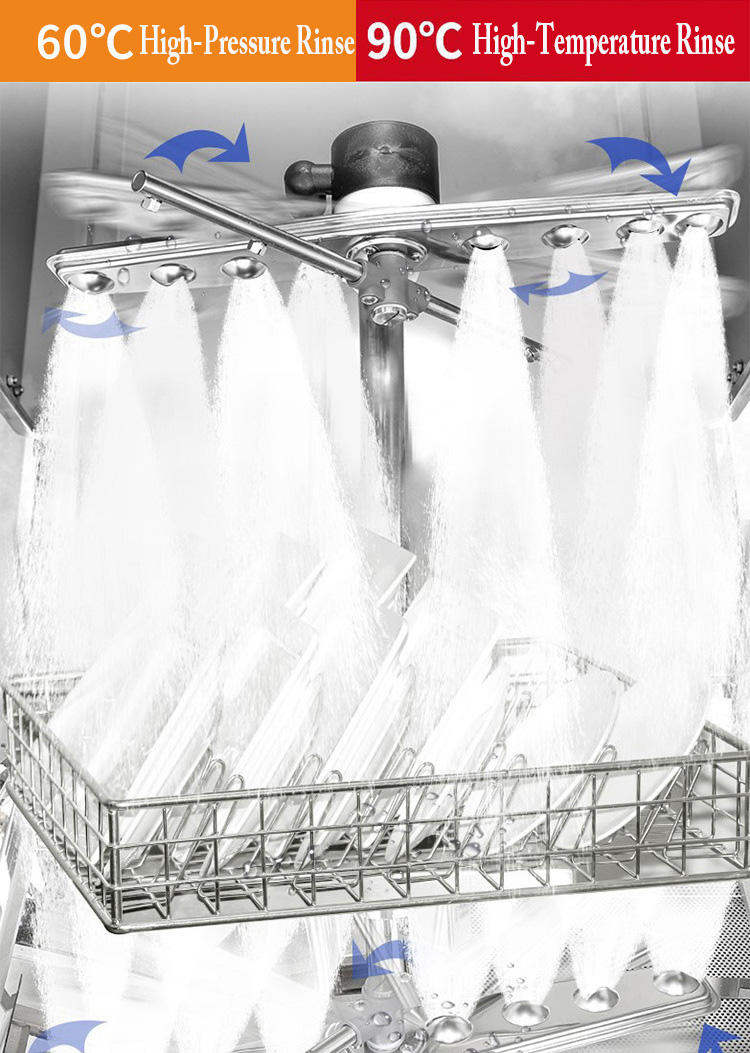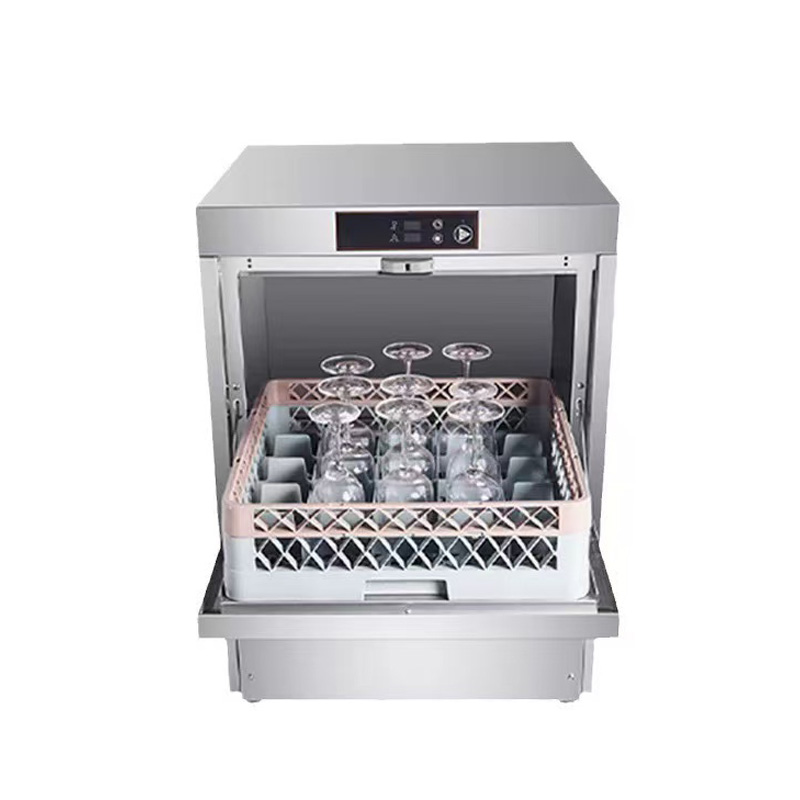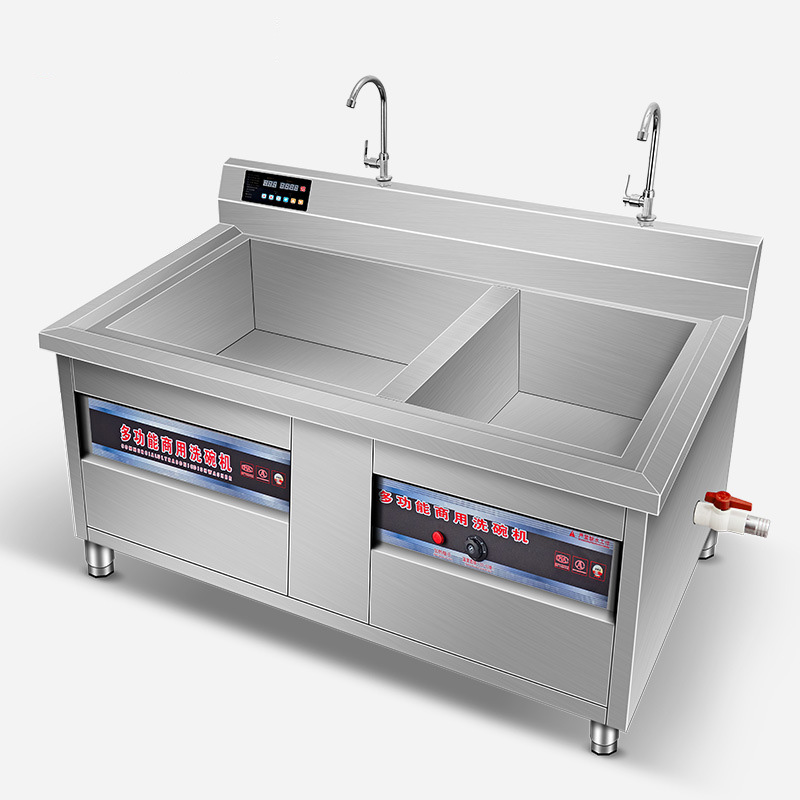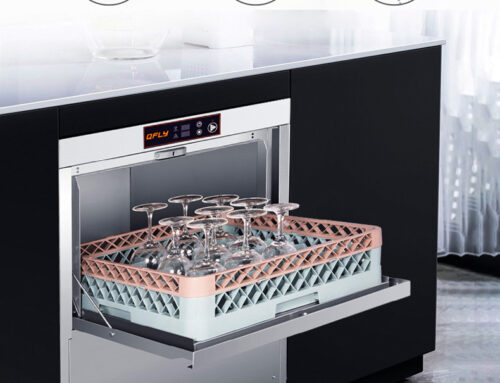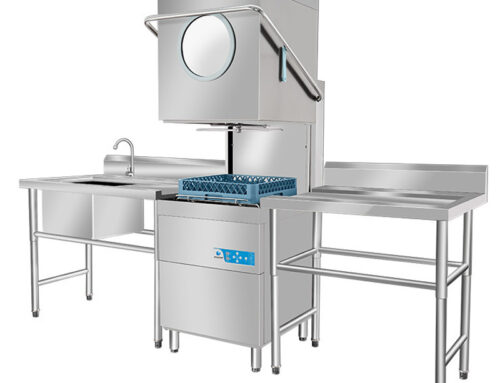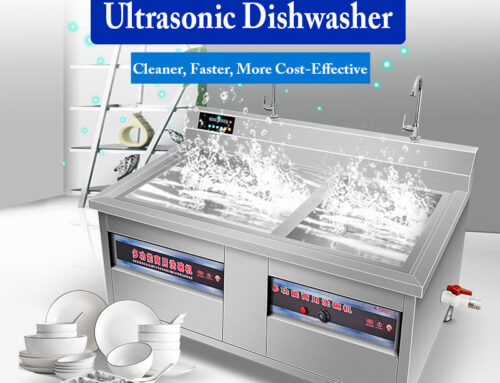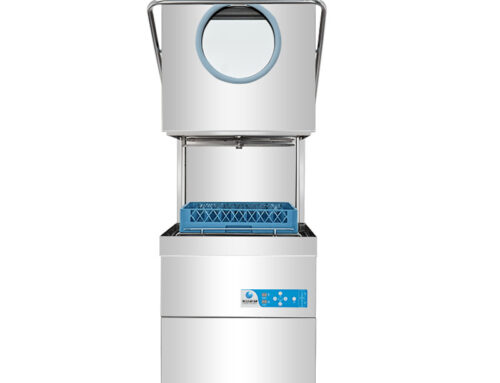What Capacity (Racks per Hour) Do You Need for Your Restaurant’s Volume?
Choosing the right commercial dishwasher capacity—measured in racks per hour (RPH)—is make-or-break for your restaurant’s efficiency. A machine that’s too small will leave you with piles of dirty dishes during peak hours, slowing down service and frustrating staff. One that’s too large wastes energy, water, and valuable kitchen space. At AT Cooker, we’ve helped thousands of restaurants find their perfect commercial dishwasher machine match, including our popular ZFGT-A 100S model (60 racks per hour). In this guide, we’ll break down how to calculate the exact capacity you need based on your restaurant’s size, menu, and customer flow—with clear examples for every type of establishment.
Small Restaurants Typically Require Commercial Dishwashers with a Capacity of 30-50 Racks per Hour
Small Establishments (10-40 Seats)
Small restaurants—like neighborhood cafes, family diners, or boutique eateries with 10-40 seats—usually operate with a small kitchen staff and a simplified menu. Their peak hours are shorter (often 1-2 hours per meal service), and they don’t generate enough dirty dishware to need a high-capacity commercial dishwasher. A machine that handles 30-50 racks per hour is more than enough to keep up with demand.
For example, a 30-seat diner that serves breakfast and lunch might use 2-3 dishes per customer (a plate, a cup, and a utensil set). During a 2-hour lunch peak, if they serve 45 customers, that’s 90-135 dishes. Since each rack holds roughly 20-25 dishes, that’s 4-6 racks per peak hour—well within the 30-50 RPH range. A compact undercounter commercial dishwasher machine (like our ZFGT-A-2D, 50 RPH) is ideal here, as it saves space while still handling daily needs.
Pro Tip: Small restaurants often overlook “hidden” dishware—like prep bowls, mixing spoons, and employee mugs. Add 10-15% to your estimated dish count to avoid undersizing your commercial dishwasher.
Medium-Sized Restaurants May Need a Commercial Dishwasher Capacity of 60-100 Racks per Hour
Mid-Size Establishments (40-100 Seats)
Medium-sized restaurants—including casual chains, busy bistros, and regional restaurants with 40-100 seats—have longer peak hours (2-3 hours) and higher customer volume. They often serve 60-100 customers per peak hour, with a menu that includes appetizers, entrees, and desserts—meaning more dishes per person. A commercial dishwasher with 60-100 RPH is the sweet spot here.
Our ZFGT-A 100S commercial dishwasher machine is a top choice for these restaurants, with a capacity of 60 racks per hour. Let’s break down why it works: a 70-seat bistro serving dinner might see 80 customers during a 3-hour peak. Each customer uses 4-5 dishes (appetizer plate, entree plate, salad bowl, glass, utensil set)—that’s 320-400 dishes. With 20-25 dishes per rack, that’s 13-16 racks per peak hour. The ZFGT-A 100S handles this easily, even with extra prep dishes and employeeware.
The ZFGT-A 100S also offers features that make it perfect for medium restaurants:
- Fast cycle times: 60/90/120 seconds per basket, so you can prioritize urgent loads (like clean glasses for the bar) during peaks.
- Low water use: 2.5-3.5 liters per rack, keeping utility costs low even with frequent use.
- Durable 304# stainless steel: Handles daily use without rust or damage, a must for busy kitchens.
Large or High-Volume Restaurants Might Require Commercial Dishwashers Handling 150-400 Racks per Hour
Large Establishments (100+ Seats)
Large restaurants—like downtown steakhouses, convention center cafes, or national chains with 100+ seats—operate at full capacity for 3-4 hours per meal service. They serve 150+ customers per peak hour, with complex menus that use multiple dishes per course (e.g., bread plates, soup bowls, entree platters). These establishments need high-capacity commercial dishwashing machines with 150-400 RPH.
While AT Cooker doesn’t currently offer conveyor-style models (the most common high-capacity type), we partner with trusted manufacturers to supply these machines to our large restaurant clients. For example, a 200-seat steakhouse serving dinner might see 250 customers during a 4-hour peak. Each customer uses 6-7 dishes (bread plate, salad bowl, soup cup, entree platter, side dish plate, glass, dessert dish)—that’s 1,500-1,750 dishes. With 20 dishes per rack, that’s 75-88 racks per peak hour—requiring a 150+ RPH machine to avoid backups.
High-capacity commercial dishwasher models often include features like:
- Continuous conveyor belts: Move racks through the machine without manual loading/unloading, saving labor.
- Multiple wash zones: Separate pre-rinse, wash, and rinse zones for thorough cleaning at high speeds.
- Heat recovery systems: Capture heat from exhaust to warm incoming water, reducing energy costs (critical for machines running 8+ hours daily).
Fast-Food Establishments Usually Need Lower Commercial Dishwasher Capacities (20-40 Racks per Hour)
Fast-Food & Quick-Service (QSR)
Fast-food restaurants and quick-service establishments (QSRs) might seem busy, but they actually need lower commercial dishwasher capacities—20-40 RPH. The reason? They use disposable packaging (paper bags, foam containers) for most meals, so the only dishware to clean is employee utensils, drink cups, and occasional dining plates (for in-store customers).
A fast-food restaurant with a drive-thru and 20 indoor seats might serve 150 customers per peak hour, but only 30 of those eat in. Each in-store customer uses 1-2 dishes (a tray, a drink cup, or a utensil set), and employees use 10-15 dishes per hour. That’s 30-60 dishes per peak hour—1-3 racks—easily handled by a 20-40 RPH machine. A compact countertop commercial dishwasher machine (like our ZFGT-A-2D, 50 RPH) is more than sufficient, and its small size fits perfectly in QSR kitchens with limited space.
Key Consideration: Fast-food kitchens often have high turnover, so choose a commercial dishwasher with simple controls (like the ZFGT-A 100S’s press switch) to minimize training time for new staff.
Fine Dining Restaurants May Require Higher Capacities for Multiple Courses & Frequent Tableware Changes
Fine Dining (20-60 Seats, High-End)
Fine dining restaurants are a unique case: they have fewer seats (20-60) than medium restaurants, but they require higher commercial dishwasher capacities (60-100 RPH) due to multiple courses and frequent tableware changes. A typical fine dining meal includes 4-6 courses (amuse-bouche, appetizer, soup, entree, cheese, dessert), each with its own specialized dishware. Servers also change tablecloths and utensils between courses, meaning more dirty items to clean.
For example, a 40-seat fine dining restaurant serving 30 customers per night (over 3 hours) might use 8-10 dishes per customer (amuse-bouche plate, appetizer plate, soup bowl, entree platter, side dish plate, cheese board, dessert plate, wine glass, water glass, utensil set). That’s 240-300 dishes per night—10-12 racks. But since dishes need to be cleaned quickly for the next course (you can’t wait until the end of service), a 60-100 RPH machine (like our ZFGT-A 100S) is necessary. Its fast 60-second cycle ensures clean plates and glasses are ready for the next course without delay.
Fine dining restaurants also value hygiene and presentation, so our ZFGT-A 100S’s high-temperature sanitization (up to 95℃) and drying feature are critical—it ensures dishware is not only clean but also free of water spots, which is essential for high-end service.
The Number of Seats in a Restaurant Is a Crucial Factor in Determining Commercial Dishwasher Capacity
Seat Count & Capacity Formula
The number of seats in your restaurant is the easiest way to estimate your commercial dishwasher needs. A general rule of thumb is:
- 1-2 racks per hour per 10 seats (small restaurants, casual dining).
- 2-3 racks per hour per 10 seats (fine dining, busy bistros).
- 3-4 racks per hour per 10 seats (buffets, high-volume chains).
Let’s test this formula with real examples:
- 30-seat casual diner: 30 seats ÷ 10 = 3 → 3 × 1-2 = 3-6 racks per hour → 30-50 RPH machine (matches our earlier recommendation).
- 70-seat bistro: 70 seats ÷ 10 = 7 → 7 × 2-3 = 14-21 racks per hour → 60-100 RPH machine (like the ZFGT-A 100S).
- 200-seat buffet: 200 seats ÷ 10 = 20 → 20 × 3-4 = 60-80 racks per hour → 150+ RPH machine.
This formula works because seat count directly correlates to customer volume—more seats mean more customers, which means more dishes. It’s a quick way to narrow down your options before diving into more detailed calculations (like peak hour flow or menu complexity).
Peak Hour Customer Flow Is Essential in Determining Commercial Dishwasher Capacity
Peak Hours & Capacity Planning
Your restaurant’s peak hour customer flow—how many customers you serve in your busiest 1-2 hours—is more important than daily total customers when choosing a commercial dishwasher. A restaurant that serves 100 customers spread over 6 hours has very different needs than one that serves 100 customers in 2 hours.
To calculate peak hour flow:
- Record the number of customers served each hour for 3-5 days (include weekends, as they’re often busier).
- Identify the 1-2 hours with the highest customer count (this is your peak).
- Calculate the number of dishes used during that peak (customers × dishes per customer + employee dishes).
- Divide by dishes per rack (20-25) to get racks per peak hour.
- Choose a commercial dishwasher machine with a capacity that’s 20-30% higher than your peak racks per hour (to account for delays or unexpected rushes).
For example, a 50-seat pizza restaurant might record:
- 5 PM: 15 customers
- 6 PM: 40 customers (peak)
- 7 PM: 35 customers
- 8 PM: 20 customers
During the 6 PM peak, they serve 40 customers (2 dishes each = 80 dishes) plus 10 employee dishes = 90 dishes. 90 dishes ÷ 20 dishes per rack = 4.5 racks per peak hour. Adding 20-30% gives 5.4-5.85 racks per hour—so a 30-50 RPH machine is more than enough. If they only looked at daily total (110 customers), they might oversize and buy a 60-100 RPH machine unnecessarily.
Menu Complexity & the Number of Dishes Used Affect Commercial Dishwasher Capacity Needs
Menu Design & Dish Count
Your menu is one of the biggest drivers of commercial dishwasher capacity needs. A restaurant with a simple menu (e.g., burgers and fries) uses far fewer dishes than one with a complex menu (e.g., multi-course Italian cuisine). Here’s how menu elements affect dish usage:
- Course count: Each course adds 1-2 dishes (e.g., soup course = soup bowl + spoon; entree course = entree plate + fork/knife).
- Specialized dishware: Menus with tapas, sushi, or tapas use small, specialized plates—you need more racks to clean the same number of dishes (small plates take up more space per rack).
- Shared plates: Restaurants that serve family-style or shareable dishes use larger platters, which take up more space in the dishwasher (1 platter = 2-3 small plates in a rack).
- Beverage service: Bars or restaurants with extensive wine lists use multiple glass types (wine, champagne, cocktail)—glasses need to be spaced out in racks to avoid breakage, so you need more racks per glass count.
Our ZFGT-A 100S commercial dishwasher machine is designed to handle diverse dishware, including glasses, ceramic cups, and small plates (as noted in its specs: “Suitable for glasses and ceramic cups”). Its 510×510mm basket size fits standard racks for plates, bowls, and glasses, making it versatile for restaurants with varied menus.
Choosing a Slightly Higher Capacity Commercial Dishwasher Supports Future Business Growth
Scalability & Long-Term Value
It’s always a good idea to choose a commercial dishwasher with a capacity 10-20% higher than your current needs. This “growth buffer” ensures you’re prepared for:
- Seasonal spikes: Holidays, tourist seasons, or local events can increase customer volume by 30-50%.
- Menu expansions: Adding more courses or specialized dishes will increase your dish count.
- Business growth: If you add seats, extend hours, or open a second location, your dishwasher can handle the extra load (or be moved to the new location).
For example, a 40-seat cafe currently needs a 30-50 RPH machine. Choosing a 50-60 RPH machine (like our ZFGT-A-2D) means they won’t need to replace it if they add 10 seats or start serving dinner. The extra cost is minimal compared to the expense of buying a new machine in 2-3 years.
Cost Tip: A higher-capacity commercial dishwasher machine may use slightly more energy, but the long-term savings from avoiding premature replacement far outweigh the extra utility costs. Our ZFGT-A 100S, for example, has a 95% energy efficiency rating—so even with its 60 RPH capacity, it’s still cost-effective for growing restaurants.
How to Accurately Assess Your Commercial Dishwasher Capacity Needs (Step-by-Step)
Practical Assessment Guide
If you want to be 100% sure you’re choosing the right commercial dishwasher capacity, follow these steps over 3-5 days:
- Count all dishware: Before service, count every piece of dishware you use (plates, bowls, glasses, utensils). Record this as your “starting count.”
- Track dirty dishware: During and after service, collect all dirty dishware in designated bins. At the end of each hour, count how many bins are full and how many dishes are in each bin.
- Calculate racks per hour: Divide the number of dirty dishes per hour by 20-25 (dishes per rack) to get racks per hour.
- Identify peaks: Note the hour with the highest racks per hour (this is your peak demand).
- Add a buffer: Multiply your peak racks per hour by 1.2 (20% buffer) to get your ideal commercial dishwasher capacity.
For example, a restaurant’s 3-day tracking might show:
- Day 1 Peak: 8 racks per hour
- Day 2 Peak: 7 racks per hour
- Day 3 Peak: 9 racks per hour
- Average Peak: 8 racks per hour
- Ideal Capacity: 8 × 1.2 = 9.6 → 30-50 RPH machine (since 9.6 is well below 30, a small machine works).
This method removes guesswork and ensures you choose a commercial dishwasher machine that fits your exact needs—no more, no less. AT Cooker can also help you analyze your data and recommend the right model, like the ZFGT-A 100S for medium peaks or the ZFGT-A-2D for smaller ones.
Conclusion: Find Your Perfect Commercial Dishwasher Capacity with AT Cooker
Choosing the right commercial dishwasher capacity isn’t about guessing—it’s about understanding your restaurant’s size, peak hours, menu, and growth plans. Small restaurants (10-40 seats) thrive with 30-50 RPH, medium restaurants (40-100 seats) need 60-100 RPH (like our ZFGT-A 100S), and large establishments need 150+ RPH. By following our formulas, tracking your dishware, and adding a growth buffer, you’ll select a machine that keeps your kitchen running smoothly for years.
At AT Cooker, we offer a range of commercial dishwasher machine options to fit every capacity need, all built with durability, efficiency, and ease of use in mind. Our ZFGT-A 100S (60 RPH) is a customer favorite for medium restaurants, with fast cycles, low water use, and stainless steel construction that stands up to daily use. Whether you’re a small cafe or a growing bistro, we have the perfect commercial dishwasher for you.
Contact us today to share your restaurant’s details, and we’ll help you find a capacity that matches your volume—no oversizing, no undersizing, just perfect performance. With our 20 years of experience in commercial kitchen equipment, we’re your trusted partner for a more efficient, productive kitchen.
